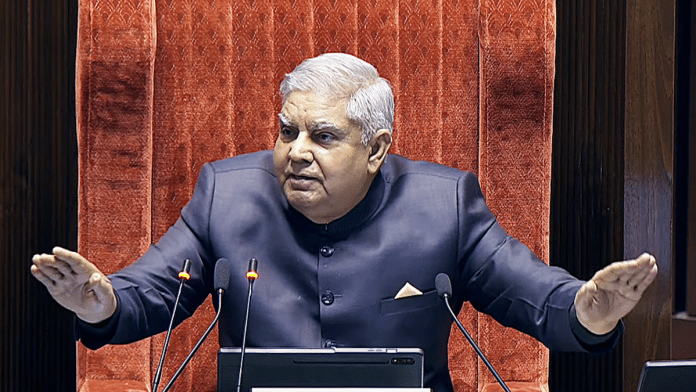“Republics are formed, not found,” wrote Philip Bobbitt in The Shield of Achilles, capturing the intentional craftsmanship behind modern constitutionalism. They are not gifts of history, but acts of memory, of caution, of design. Constitutions are not accidental artefacts, they are blueprints of humility, instruments to channel and control power. When the Vice President raises concern over the Chief Justice of India’s role in appointing the CBI Director, he touches not on privilege, but on architecture. This is not abstract theory; it is the grammar of a functioning republic. India did not choose the American isolation of powers or the British concentration. We chose a tensioned architecture, where each power leans against the other, not to destabilise, but to steady.
The CJI’s statutory presence in appointing the head of the nation’s premier investigative agency is not a fluke of legal drafting, it is a structural feature. It is a successor to experiences where power went unchecked: the Emergency’s weaponisation of law, the Hawala scandal’s institutional paralysis.
The insertion of judicial oversight was neither accidental nor theoretical. Vineet Narain v. Union of India (1997) emerged from the public shock of the Jain Hawala diaries, its essence was doctrinal, not defensive. The Supreme Court held that the need of the hour is to insulate the CBI from extraneous influence. It insisted on structural measures, not temporary decrees. Parliament listened: the Lokpal and Lokayuktas Act, 2013 entrenched a tripartite panel for the selection of the CBI director — the PM, LoP, and the CJI or his nominee — forming a legal bond between democratic design and historical necessity.
Perception and principle
If anyone doubts the continuing vitality of that design, recent jurisprudence confirms it. In Common Cause v. Union of India (2021), the Supreme Court upheld statutory requirements for fixed tenure, noting that transparency in appointment and continuity in office are “constitutional imperatives that flow from independence.” It struck down executive efforts to circumvent the panel. In Dr. Jaya Thakur v. Union of India (2023), the SC further condemned post-tenure extensions as injurious to public perception: where “perceived capture” prevails, institutional legitimacy collapses.
This is not unique to India. Across democratic orders, judicial participation in appointments to sensitive public offices is a safeguard, not a subversion. In the United Kingdom, the Judicial Appointments Commission includes judges in appointments beyond the bench, extending into review boards for oversight bodies. In Canada, judicial members sit on selection panels for integrity commissioners, privacy regulators, and national security review boards. South Africa’s Chief Justice serves as the chairperson of the Judicial Service Commission, which advises on prosecutorial oversight. In Israel, the Attorney General, akin to the CBI Director, emerges from a multi-stakeholder process that includes judicial members. Indeed, to place entire control of coercive institutions within the executive is not an act of democracy, it is Hobbes without honesty. It is a rehearsal of Leviathan, cloaked in constitutional formalities but stripped of institutional conscience.
The CJI’s seat at the table is not a throne, it is ballast. It prevents the investigative state from drifting toward political shores. As constitutional scholar Aharon Barak noted in the Israeli context, “Judicial participation in public appointments is not to blur the boundary between powers, but to clarify their mutual restraint.” Concerns around post-retirement appointments of judges are not frivolous. They strike at the heart of perceived impartiality. But to conflate that concern with the statutory presence of the judiciary in a democratic appointment process is both analytically lazy and constitutionally unsound. The answer lies in reform, not removal. If Parliament is indeed serious, it may codify a cooling-off period, apply it prospectively and uniformly, and preserve both perception and principle.
Also read: Shantonu Sen’s CBI tenure was a long battle against corruption—and political interference
A quiet reminder
In K. Veeraswami v. Union of India, (1991) 3 SCC 655, the SC acknowledged that even unproven allegations can erode public confidence in the judiciary. But that danger cannot justify the dismantling of institutional checks elsewhere. Perception is vital but it must not overpower constitutional intention. One must also resist the urge to confuse participation with dominance. The CJI is one of the three members on the panel for the appointment of the CBI director. He does not hold a veto. His presence is not a counter majoritarian triumph, it is a quiet reminder that public power must not be shaped behind closed doors. To deride that presence as judicial intrusion is to forget the very scandals that demanded it.
Yes, constitutions evolve, but they do so by memory, not amnesia. The appointment structure being criticised was crafted after inquiry committees, court orders, and parliamentary deliberation. It came not as an innovation but as an inheritance. To question it casually is to misremember our own institutional biography. As John Emerich Edward Dalberg-Acton warned, “The danger is not that a particular class is unfit to govern. Every class is unfit to govern.” That includes the Bench, the executive, and the legislature. Which is why the framers, and later Parliament, placed each beside the other, not to dominate, but to co-discipline.
This is not the judiciary conquering executive space, nor the executive retreating into symbolism. This is equilibrium earned through political pain, preserved through constitutional memory.
The author is an advocate practicing before the Supreme Court of India. Views are personal.
(Edited by Aamaan Alam Khan)







It would be a very healthy convention to seek unanimity for appointments where LoP is a member. Else he will routinely be overruled, 2 – 1. To circulate service records of candidates well in time, for these to be studied before the meeting. Institutions affected by osteoporosis will not take India to the First World.